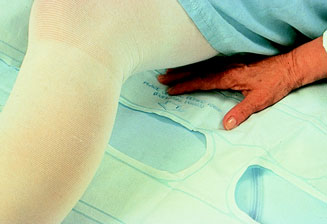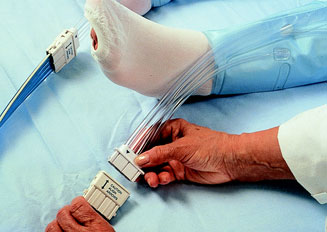Purpose
- Promote venous return from legs to decrease the risk of deep vein thrombosis and pulmonary embolism in clients with reduced mobility
Assessment
- Identify clients at increased risk for development of deep vein thrombosis.
- Assess skin integrity and identify any existing leg condition that would be exacerbated by use of the plastic sleeve or compression device. Clinical examples in which use of SCD is contraindicated are:
- Dermatitis, cellulitis
- Postoperative vein ligation
- Gangrene
- Recent skin graft
- Massive edema of legs
- Extreme deformity of legs
- Suspected or existing deep vein thrombus
- Verify physician order.
Equipment
- Measuring tape
- Compression sleeves
- Inflation unit
- Antiembolism stockings (optional)
Procedure
-
Measure leg to ensure proper sleeve sizing. Note: Knee length-one size fits all; thigh length-measure length of leg from ankle to popliteal fossa. Measure circumference of thigh at the gluteal fold. Use the correct sleeve size, as follows: extra small (circumference, 22 inches; length, 16 inches); regular (circumference, 29 inches; length, 16 inches); extra large (circumference, 35 inches; length, 16 inches).
Rationale: Proper sleeve size ensures proper fit and function of the sleeve.
-
Apply antiembolism stockings. Ensure that there are no wrinkles or folds (see Applying Antiembolic Stockings). Note: Stockinette or Ace wraps are recommended options if client cannot be fitted with antiembolism stockings.
Rationale: Wearing stockings decreases the risk of skin irritation and diaphoresis under the plastic sleeves.
-
Place client in supine position.
Rationale: Proper positioning makes it easier to secure plastic sleeve.
-
Place a plastic sleeve under each leg so that the opening is at the knee. If only one sleeve is required, leave the other sleeve in package and connect to control unit (Fig. 1).
Rationale: Unit will not reach proper pressure if single sleeve is left to inflate in unconfined area.

Fig. 1: Place plastic sleeve under leg.
-
Fold the outer section of the sleeve over the inner portion and secure with Velcro tabs. Check sleeve fit. Two fingers should fit between the sleeve and leg (Fig. 2).
Rationale: Proper fit prevents irritation to the leg and allows the unit to reach adequate inflation pressure.

Fig. 2: Secure plastic sleeve around leg.
-
Connect tubing to control unit. The premarked arrows on the tubing from the sleeve and from the controller must be aligned to make adequate connection (Fig. 3). Turn machine on (Fig. 4).
Rationale: Control unit performs a system self-check.

Fig. 3: Connect tubing to control unit.

Fig. 4: Turn on control unit.
-
Adjust control unit settings as necessary. Unit control is preset with sleeve cooling in "off" position and audible alarm in "on" position. Sleeve cooling should be in "on" position at all times except during surgery. Ankle pressure should be set at 35-55 mm Hg.
Rationale: Plastic sleeves can become warm and uncomfortable if cooling is in "off" position. Skin and stocking under sleeve can become wet with diaphoresis, which increases risk for impaired skin integrity. Cooling may be turned "off" during surgery to
-
Recheck control unit settings whenever unit has been turned off.
Rationale: The unit will convert to preset mode.
-
Respond to and promptly correct all "fault" indicator alarms. Note: The control unit will sense and indicate four pressure "fault" conditions: (a) pressure failed to drop to zero during the cycle; (b) the ankle pressure failed to reach 20 mm Hg for five consecutive cycles; (c) the ankle pressure exceeded 90 mm Hg; (d) internal diagnostics error has occurred.
Rationale: Maintains legal record and communicates with health team members.
-
Document time and date of application. If SCD is applied to only one leg, document reason.
Rationale: Maintains legal record and communicates with health team members.
-
Assess and document skin integrity every 8 hours.
Rationale: Frequent assessment of skin integrity is necessary to prevent and provide early intervention in case of skin irritation.
-
Remove sleeves and notify physician if client experiences tingling, numbness, or leg pain.
Rationale: These findings may indicate nerve compression.
| Sample Documentation | ||
| 09/10/10 | 1300 |
P: Impaired peripheral circulation. I: SCDs off to ambulate, c/o of having to wear SCDs, teaching included the importance of SCDs to prevent blood clots and the need to use whenever in bed until he is ambulating 3-4 hours per day. Statistics cited re number of deaths due to pulmonary emboli. Agrees to comply with therapy and try to ambulate more. E: Toes warm, no calf swelling or discomfort, continue to encourage ambulation and continual use of SCDs while in bed or in the chair. S. Roberts, RN |
Collaboration and Delegation
- Unlicensed assistive personnel frequently remove and then reapply SCDs as they help clients ambulate or shower. Check to ensure that SCDs are reapplied so that clients do not experience long periods without the SCD in place to promote circulation.